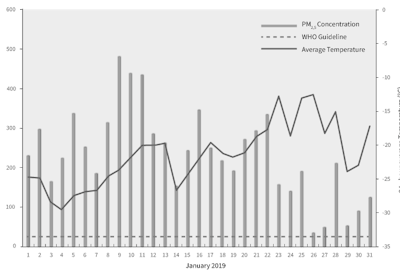The extreme cold spell over large parts of the United States at the end of January was a remarkable extreme event. Another recent event was the airing of the documentary “The world’s dirtiest air” on Australia’s SBS Dateline. The documentary featured air quality in Ulaanbaatar, Mongolia. These two events raise the question “What happens to air quality during a cold snap?”
Ulaanbataar has a bitterly cold winter and extremely poor wintertime air quality. The figure below shows Ulaanbaatar’s average daily temperature overlain on a plot of average daily PM 2.5 (particulate matter less than 2.5 microns in diameter) for January 2019.

Figure 1 : Average daily PM2.5 and corresponding temperature for Ulaanbaatar Airport in January 2019 (sources: U.S. Department of State for air quality data and National Climatic Data Center, U.S. Department of Commerce for temperature data)
At first glance, the extreme PM 2.5 concentrations, which consistently exceeded the World Health Organisation Guideline value (by as much as 20 times), appear to be directly related to the average daily temperature (also shown on the graph). Lower PM 2.5 levels roughly coincided with less frigid temperatures. So, would the US cold snap also deliver extremely poor air quality?
The answer is a little complicated. Colder weather often does result in higher pollution, especially in less developed countries where wood or coal burning is necessary for warmth.
But a seemingly odd thing is that the onset of a cold snap generally brings much better air quality. This needs a bit of explanation.
Cold snaps can bring cleaner air
Cold spells (or cold snaps) are a part of the earth’s heat regulation machinery. They represent horizontal heat transfers where masses of cold and warm air move into and out of their usual locations due to very active weather systems. Without this sort of heat exchange, the polar regions would get colder and the tropical regions would get hotter.
In the mid-latitudes, this heat exchange is initiated by a disturbance along a region called the Polar Front. This creates a low-pressure system with warm air moving poleward to the east and cold air moving equatorward to the west of the system. The cold air moving equatorward creates a sharp temperature boundary – called a cold front.
When a cold front approaches a location, air pressure drops, warm winds strengthen, cloudiness increases, and rain often occurs. These windy conditions help to dilute and disperse air pollution and so air quality is generally good.
As the cold front passes, temperatures fall, cloudiness decreases and showers (snow or rain) generally decrease and winds change direction. In the immediate aftermath of the cold front, air quality is usually still quite good because of the relatively strong winds. Rain and snow can also clean the air by scrubbing out particles and polluting gases.
What happens after the cold front passes?
After the cold front passes, the next system to move in is an anticyclone (high pressure system). This brings a decrease in wind speed and typically clear skies. With the clear skies, nights become calm and cold with temperature inversions forming, especially in valleys where colder air pools. These conditions are known as ‘stable’.
Under these calm stable conditions, pollution emitted from industry, cars and domestic heating cannot disperse efficiently in either a horizontal or vertical direction. With these poor dispersion conditions, air quality becomes poorer as pollution remains trapped and accumulates. These conditions persist until the anticyclone is displaced and stronger wind can clear out the pollution. This brings us full circle to the case of Ulaanbaatar ( Figure 1 ). The extremely poor air quality experienced there is the result of the Siberian anticyclone with its associated clear skies, light winds and inversions. This weather feature remains stationary over north-eastern Asia during the winter months and so there is ample opportunity for pollution to build up. While the weather is bitterly cold, it is not a cold snap per se.
So to answer our question, air quality usually improves during a cold snap but progressively gets worse in the aftermath as the anticyclonic conditions that follow it bring stable conditions and a buildup of pollution. Apart from increased wood and coal combustion for heating, poor air quality can therefore not be directly attributed to cold snaps, but rather to winter anticyclonic conditions.
